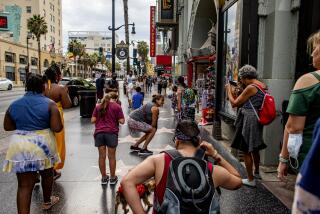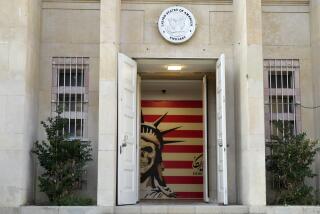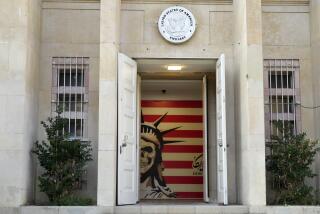Iran Working to Revitalize Tourism
- Share via
TEHRAN — Guards at a fine art museum gape in curiosity at a foreign visitor inspecting examples of Persian portraiture.
An Iranian couple’s footsteps echo down empty corridors at Tehran’s Sa’d Abad palace, almost the only visitors to the gaudy finery of a home of the former Shah Mohammad Reza Pahlavi.
Iran remains firmly off the beaten track for most tourists, seen as a place of turmoil following the 1979 Islamic revolution that toppled the shah and the 1980-88 war with Iraq.
But now the Gulf country that seems to wear its political isolation as a badge of pride wants to revive a withered tourist industry to earn foreign exchange to repay big foreign debts.
Western and other tourists--including those from the “Great Satan” America--are welcome.
“We try to separate tourism from political problems,” says the official in charge of tourist promotion, Hossein Taheri.
“Every person who wants to come to Iran is welcome, including, of course, Americans. There must be no Israelis. But about all the others, we do not mind at all,” he said in an interview.
“We are interested in attracting educated, high-income people who will be able to understand our culture, humanity and values,” said Taheri, deputy minister for tourism and pilgrimage affairs in the Ministry of Culture and Islamic Guidance.
*
So would Western backpackers be welcome too?
“Why not? If they respect our customs,” Taheri said, referring to a rule that women wear head scarves and that both sexes wear modest clothing.
He said tourists in groups were more welcome as they were easier to manage, but mentioned approvingly a French scholar of Persian studies who toured desert areas alone by camel.
Iran was once a high-profile destination for wealthy Western tourists, particularly during the skiing season, when visitors could combine the sport with visits to artistic, archeological and Islamic treasures in Isfahan, Shiraz, Mashhad and Hamadan.
The number of tourists averaged about 600,000 a year.
Iran was also a favorite stop on the 1970s hippie route to India, Nepal and Afghanistan. Students stayed in youth hostels in downtown Tehran, smoking hashish and painting pictures of cone-shaped Mount Damavand that soars spectacularly to the east.
But tourist earnings plummeted after the revolution.
Some Shiite Muslim pilgrims from the Gulf and South Asia continued to visit the holy city of Qom and a major Islamic shrine in Mashhad. But the world’s tourists steered clear of a country that radiated hostility to foreign influence.
Signs still abound of revolutionary-era fervor and economic underdevelopment wrought by isolation.
“Down with America” reads a big sign on the wall of a lobby of a five-star Tehran hotel. Air conditioning is primitive and hotel television sets, when they work, show lengthy religious programs or propaganda films about the war against Iraq.
*
But for the kind of up-market tourist Iran is seeking, these are conditions worth tolerating in return for the chance to make contact with a culture grown more exotic with isolation.
Expatriates argue Iran’s isolation has led popular opinion in the West to assume wrongly that Gulf culture consists entirely of the austere societies on the Arab side.
“It’s interesting to see another civilization and politics,” said one French tourist. “You can’t see this in the media. You have to visit. And people do speak to us, even if it is sometimes only in the privacy of their homes.”
Taheri said he planned to quadruple the number of foreign visitors to 2 million annually by the year 2000, from 510,000 in 1995. Two million visitors a year would bring the country $2 billion, he said, equivalent to a hefty 12% of Iran’s total exports at present.
Authorities are building new hotels in Mashhad, Tehran, Isfahan, Kerman and Shiraz. The campaign appears to be working. The number of arrivals in 1995 was 40% up from the total in 1994, which in turn was a 45% rise on arrivals two years before in 1992.
Visitors from the Americas made up only 0.7% and West Europeans only 10% of 1994 arrivals. The largest number of visitors were from South Asia and eastern Europe.
South Asian visitors include pilgrims to Islamic holy sites.
More to Read
Sign up for The Wild
We’ll help you find the best places to hike, bike and run, as well as the perfect silent spots for meditation and yoga.
You may occasionally receive promotional content from the Los Angeles Times.






